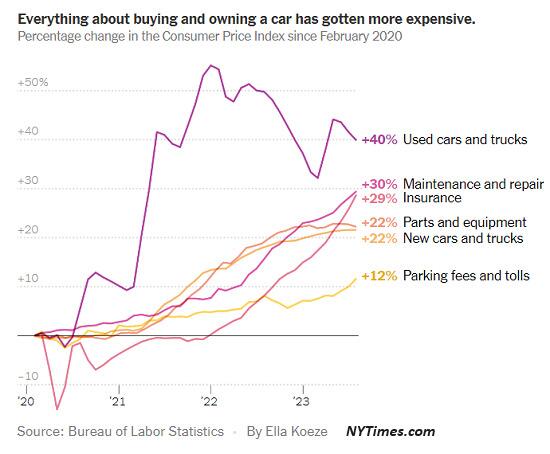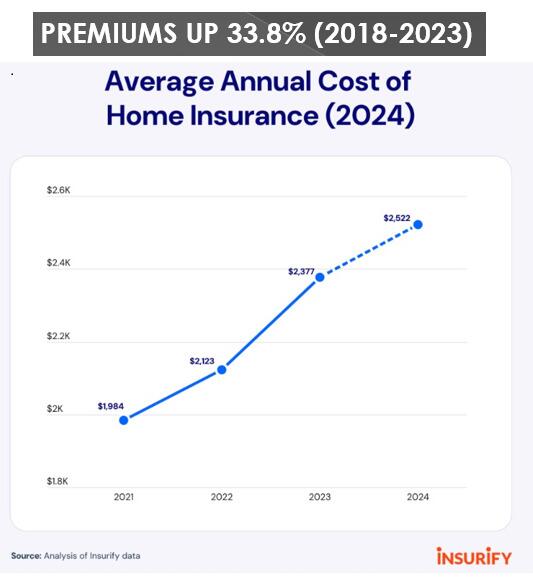The Big Shining Lie: We're Better Off Now...
Authored by Charles Hugh Smith via OfTwoMinds blog,
This is proof-positive we're not just poorer now than we were 40 years ago, we're much, much poorer.
Armies of well-paid apologists, apparatchiks and propaganda peddlers--economists, pundits, statisticians, influencers--spend their entire careers pushing a big shining lie; we're more prosperous now than ever before. This is demonstrably false, as the truth--that we're much poorer than we were 40 or 50 years ago--would disrupt the status quo in which the few at the top get to control the narratives and wealth as long as the masses believe the propaganda that we're all better off.
This is the reason why the four-decade collapse of the purchasing power of wages must be papered over with propaganda and gamed statistics. If we accept the reality of our declining standard of living and well-being, then a few reforms will be recognized as insufficient; we'll awaken to the necessity of a Reformation, not just a handful of standard-issue policy tweaks.
Inflation statistics are easily gamed. So are statistics such as median wages. Official inflation is gamed by various statistical tricks (hedonics and what's in the price basket) to understate the real-world decline in purchasing power.
There is only one true measure of prosperity: the purchasing power of an hour's labor / wage. It doesn't matter what the wage or price numbers are, what matters is: how much can you buy with an hour's wage?
Fact: in 1977, it took 2.25 days of work (18 hours) to pay the monthly rent on my studio apartment in the most expensive city in the U.S., Honolulu. In virtually any other city or town, the rent would have been less. I was 23 years old, working as a non-union apprentice carpenter for a small contractor. The pay was a bit above average, but by no means fabulous. I wasn't working at Goldman Sachs. The rent was fair market; it wasn't some special deal offered by a relative.
Since this was a cheap apartment, let's round that up to 3 days of work to pay the monthly rent.
OK, so how many young wage earners today can pay the rent for their own apartment with 3 days' pay? Any hands? OK, the Ivy League MBA working at Goldman Sachs, making mega-six-figures in annual compensation. Any average folks out there paying their rent with 3 days' pay? No?
Today, that would require an hourly wage of $60 to $90 an hour. The median annual wage is around $60,000, around $30/hour--half or a third of what it takes to pay the rent on a studio apartment in a high-cost urban area with 3 days of work.
It's important to understand that I didn't have the only cheap apartment in the city. Most of my friends had similar cheap housing, because there were more nooks and crannies in the housing market and in the economy: more small landlords and lower costs of doing business. One friend rented a converted WW2-era Quonset hut on the edge of an upscale neighborhood. Another lived in an old apartment next to the freeway. Another rented an in-law cottage in a single-family home neighborhood. I rented a wealthy couple's poolside cabana for a year. (Most of the space was filled with their stuff, but the price was right.)
Much of this low-cost housing has been demolished or rehabbed into high-priced rentals.
Fact: in 1985, it took about four hours of work to pay my individual healthcare insurance premium for the month ($54). This wasn't phantom insurance with a huge deductible--it was the standard insurance offered by employers large and small. Being self-employed, I paid the premium myself.
OK, everyone who can pay a market-rate, non-subsidized, non-giant-deductible monthly healthcare insurance premium (for an individual) with good coverage with 4 hours of work, raise your hand. With an average cost around $350 a month according to reputable sources, that requires a wage of $87 an hour--roughly triple the median wage.
Costs were lower across the board: my monthly utility bill: two hours of work. Three full lunches at a working-class cafe--one hour of work. And so on. The key takeaway here is that the cost of doing business was lower across the board, so everything from auto repairs to going to the dentist was much cheaper. Compared to the present, it took very few hours of work to pay for auto repairs, dental work and other services.
We're told our vehicles are so much better now, but this too is open to debate. Cars and trucks cost a fortune now, and they're bigger and heavier and dependent on electronics that can't be repaired at home and that are super-costly to repair. And what exactly makes them so much better? Recall that we all managed to get by without rearview cameras and hands-free mobile phone technology for decades. Let's look at vehicles as transport, not rolling entertainment centers.
My 1979 Honda Accord (bought used for $2,600 ($7,350 in today's dollars) operated for many years with little more than routine maintenance despite being 8 years old when I bought it. It got about the same mileage (40 MPG) as my current 2016 Civic, which has a bigger engine and is much heavier. Is it a "better" vehicle given that repair estimates of $3,000 or more are now the norm? I could still replace a defective sensor in my 1998 Civic myself. Now--forget it.
In terms of repairability, modern vehicles are off-the-scale worse than the highly reliable vehicles of 30 or even 40 years ago.
Given the impossibility of doing much more than changing the oil at home and the insane costs of repairs, it's clear that the hedonics aren't worth the stupefying increases in costs. The same can be said of the 4-cylinder pickup trucks of that era, which did the same work as the far larger, far more costly and unrepairable trucks of today that cost $80,000. How many hours of work does it take now to own and operate a vehicle? Far more than in the past.
In the 1980s, I paid my annual home insurance with a few days' labor. Is that possible now? Sure, if you make $80/hour. Even at that rate, it takes a couple weeks' earnings to pay home insurance in some areas. And yet we're all more prosperous now?
How about the cost of building a new home? In the early 1980s, I built my own 1,400 square foot conventional house with a two-car garage for $26,000, which equates to about $90,000 in today's dollars. It took 2,600 hours of work to pay for my house in full (not counting my carpentry labor). I performed all the labor other than the licensed subcontractors (electrical, plumbing, cesspool excavation, carpet installation, etc.).
Can an owner-builder construct the equivalent house today for 2,600 hours of work? At $30/hour, that's $78,000. Good luck building a middle-class house turnkey (all appliances, flooring, etc.) for $78,000, even if you do all the carpentry yourself. That might cover the materials--but maybe not.
Around this same time (1983) I built numerous modest starter homes as a fully licensed and insured contractor for under $35,000, which equates to $110,000 in today's dollars. Compare this to today, where you need a construction loan of $400,000 to build a nothing-special middle-class house.
Are the houses "better" today? In terms of the quality and durability of materials and appliances, they're worse. The materials today are low quality, as are the appliances. 30 or 40 years ago, you could buy a fridge, washer, stove/oven, etc. and it would last decades. Now, all I hear are accounts of costly appliances failing in a few years--and that's been my experience. Today's lumber is lower quality, too, as is the hardware. Standard (i.e. not fancy-expensive) locksets in 50-year old houses are still untarnished and working fine. Modern hardware is--sorry to be blunt--mostly rubbish.
Meanwhile, as the costs in hours needed to pay for essentials have soared, we're told by apologists and propaganda pundits that cheap TVs and clothing have offset the the collapse of our purchasing power. Does anyone else find this ceaseless spew of lies irksomely misleading?
The collapse of quality has stripped away the purchasing power of earnings. Two generations ago, you could buy just about anything you needed used for a low cost, and that product would last for years or decades. My Mom bought a "vintage" dining set in 1970 that supposedly came around the Horn. Given the square nails and other indicators, I would estimate it was 100 years old at that time. I still use it today, so it's 150 years old. I've reglued some of the chairs, but other than that, they've been zero-cost for 50 years.
Are the chairs being bought today at Ikea going to last 150 years? I've repaired many that fell apart in the first year. The same can be said of almost everything being manufactured today. This collapse of quality has dramatically reduced the purchasing power of wages in fundamental ways.
Then there's this chart: wages' share of the economy, which has dropped from 51.6% in 1975 to 43% today. Given that the U.S. GDP is $29 trillion, each point of that decline translates into major money. 8% of $29 trillion is $2.3 trillion. Now there are various ways to measure this, but you get the point: wage earners are receiving a smaller share of the economy's output.
How many hours of work does it take to buy essential products and services now, and how long do the products last? By this measure, we're poorer, much poorer. After paying for essentials, we have less disposable income available to save or spend on non-essential stuff.
In the mid-1970s, I was having lunch with two older buddies. One was a public school teacher (he taught science) who'd served in West Africa in the Peace Corps, the other was an ex-Marine officer who'd served boots on the ground in Vietnam. Both agreed that if anyone was serious about achieving anything that required money, they had to save 40% to 50% of their net pay. Anything less indicated they weren't actually serious.
With even an average measure of frugality, this was entirely possible. It was well within reach. How many wage earners today save 40% - 50% of their net pay? Sure, some do, but how many do so without help from the family, special discounts or subsidies, or earnings in the top 10%? Not many. And this is proof-positive we're not just poorer now than we were 40 years ago, we're much, much poorer.
If we refuse to accept reality, what are the chances we'll be able to fix what's broken? Delusion and wishful thinking are not successful survival strategies.
* * *
More personal-finance stories on ZeroHedge

US New Home Sales Surged In March As Mortgage Rates Tumbled, But...

Nearly Half Of US Home-Sellers Are Offering Buyer Concessions

Disney Scrambles With Park Discounts As Most Magical Place On Earth Has New Location
NEVER MISS THE NEWS THAT MATTERS MOST
ZEROHEDGE DIRECTLY TO YOUR INBOX
Receive a daily recap featuring a curated list of must-read stories.








